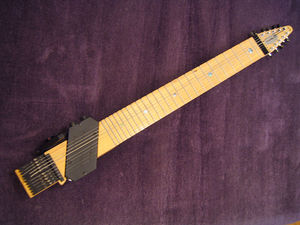Chapman stick
The Chapman Stick is an electric fretted stringed instrument that essentially consists of a large fingerboard with 8 to 12 strings and one or two induction pickups . The basic version was developed in the late 1960s by jazz guitarist and session musician Emmett H. Chapman (* 1936) from Los Angeles.
Emmett Chapman is the president of the only manufacturing company (under patent law), Stick Enterprises. The Chapman Stick has been manufactured and sold commercially since 1974. Around 7000 pieces have been sold so far. It is estimated that there are around 2,000 to 3,000 embroidery players around the world who mainly work in the rock , jazz or experimental music scenes .
Function and style of play

For playing, the instrument is attached to the body with a belt clip and a neck loop so that it hangs almost vertically in front of the player. The playing technique used is the tapping known from (especially electric) guitars and basses . Here, the strings are hit with the fingertips on the frets, causing them to vibrate. In the case of guitars or basses, the sound vibrations generated in this way are rather weak compared to a struck string, so the amplitudes of the string vibrations are small. To compensate for this, Chapman developed the so-called low-tension principle; here the strings are less tense than with guitar or bass. The stick is therefore much better suited for the tapping technique than conventional electric guitars and basses.
The standard model has 10 strings, which are divided into a bass group and a treble group, with the lowest string in the middle and the highest on the edge of the fingerboard. The strings of the bass group rise in fifths, those of the treble group rise in fourths. The game is played with both hands, with the option of using both groups of strings at the same time and the option of playing with both hands in one group.
As for the tuning of the strings, there are many options. In the classic method, the lowest bass string is tuned to C and the lowest treble string to F sharp.
Models
There are currently seven different models of the Chapman Stick:
- Standard stick or "The Stick" (10 strings, 5 treble and 5 bass strings)
- Grand Stick (12 strings, 6 treble and 6 bass strings, less often 7 treble and 5 bass strings)
- Stick Bass (SB8) (8 strings, 4 treble and 4 bass strings, alternatively 8 bass strings)
- NS / Stick (8 strings for all playing techniques, plucking, tapping, slapping; was developed together with Ned Steinberger, 34 ″ scale )
- Ten String Grand (10 strings, 5 treble and 5 bass strings with significantly larger string spacing)
- Alto Stick (10 strings, 5 treble and 5 bass strings, with a shorter scale length for higher pitches)
- SG12 (12 strings, 6 treble and 6 bass strings, with a shorter scale length for higher pitches)
- Railboard (model made of aluminum - instead of wood or made of polycarbonate, with 34 ″ gauge)
The Stick, Grand Stick and Stick Bass have a 36 "gauge, older models have a 34" gauge.
Emmett Chapman also experimented with midi interfaces; a fully midified standard stick is also available, which is called "The Grid".
Stick player
Best-known players (alongside Emmett Chapman) are the American session musicians Tony Levin and John Myung from Dream Theater . This can be seen very well on the "Live At Budokan" DVD in the song New Millennium . In addition, this musical instrument is often used by Sean Malone ( Cynic ) for his compositions. Nick Beggs ( Kajagoogoo , Ellis, Beggs & Howard , Steven Wilson ) also performs live with this instrument. In Europe, Hans Hartmann is considered one of the best Chapman stick players. Frank Jolliffe also excelled with the instrument . Fergus Marsh played the stick in 1984 on the album Stealing Fire by Bruce Cockburn and at his live concerts, z. B. in the WDR - Rockpalast . The native Swede Andy Salvanos lives in Australia and plays his own compositions with a stick.
Pieces in which the stick was inserted
- Elephant Talk by King Crimson , played by Tony Levin
- Last words from Saltatio Mortis , played by Brother Frank
- New Millennium by Dream Theater , played by John Myung
- Your Attention from Blue Man Group
- San Jacinto by Peter Gabriel , played by Tony Levin
- Sleep and Who Can Stand in the Way from Midnight Oil , played by Peter Gifford
- The Lion's Mouth by Kajagoogoo , played by Nick Beggs
- Big Bubbles, No Troubles by Ellis, Beggs & Howard , played by Nick Beggs
- The Holy Drinker by Steven Wilson , played by Nick Beggs
- Beneath The Waves from Compendium, played by Nick Beggs
- Cavatina von Santana , played by Alphonso Johnson
literature
- Harald Thon: Already a keyboard or still a guitar? EH Chapman is working on the future of the electric guitar. Guitar & Laute 1 (1979), 5, pp. 28-33
Web links
- www.stick.com Site of the manufacturer (English)
- www.chapman-stick.de
- Article about the Chapman Stick and the German stick scene at myoon
Individual evidence
- ^ Hannes Fricke: Myth guitar: history, interpreters, great hours. Reclam, Stuttgart 2013, ISBN 978-3-15-020279-1 , pp. 12 and 232.
